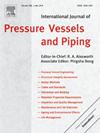Microstructure and mechanical properties of TIG and TIG+ FCAW automatic welded joints of X70 pipeline steel at 45° slope
IF 3
2区 工程技术
Q2 ENGINEERING, MECHANICAL
International Journal of Pressure Vessels and Piping
Pub Date : 2025-01-24
DOI:10.1016/j.ijpvp.2025.105450
引用次数: 0
Abstract
Butting welding of X70 pipeline steel at 45° slope were conducted by automatic hot-wire tungsten inert gas arc welding (TIG), and automatic TIG + flux core arc welding (FCAW). Optical microscopy (OM) and scanning electron microscopy (SEM) were used to analyze the microstructures of two welded joints. Meanwhile, mechanical properties of two welded joints, such as tensile, bending, hardness and impact were measured. The results show that, for TIG + FCAW joint, the proportion of large-angle grain boundaries is greater than that of small-angle grain boundaries for the whole weld. For the HAZ of the both welded joints, the proportion of small-angle grain boundaries of the upper groove is higher than that of the lower groove. Both the grain size and hardness of the HAZ-upper is higher than that of the HAZ-lower. But the impact energy of the HAZ-lower is much higher than that of the HAZ-upper. Therefore, the slope affects the properties of welded joints. In addition, the temperature influences the impact energy. For TIG joint, the impact energy at room temperature (25 °C) is generally higher than that at −10 °C. For TIG + FCAW joint, the impact energy of both the HAZ at 3 o'clock and the fusion line at 6 o'clock at 25 °C is lower than that at −10 °C. In view of the high strength and good toughness of the TIG + FCAW joint, TIG + FCAW welding process is more suitable for X70 pipeline steel welding.
X70管线钢45°斜面TIG和TIG+ FCAW自动焊接接头的组织与力学性能
采用自动热丝钨极惰性气体电弧焊(TIG)和自动TIG +药芯电弧焊(FCAW)对X70管线钢进行45°坡面对接焊。采用光学显微镜(OM)和扫描电镜(SEM)对两个焊接接头的组织进行了分析。同时,对两种焊接接头的拉伸、弯曲、硬度、冲击等力学性能进行了测试。结果表明:对于TIG + FCAW接头,整个焊缝中大角度晶界的比例大于小角度晶界的比例;对于两个焊接接头的热影响区,上坡口的小角度晶界比例高于下坡口的小角度晶界比例。haz上部的晶粒尺寸和硬度均高于haz下部。但下haz层的冲击能远高于上haz层。因此,斜度会影响焊接接头的性能。此外,温度对冲击能也有影响。对于TIG接头,室温(25℃)时的冲击能一般高于- 10℃时的冲击能。对于TIG + FCAW接头,25℃时3点钟方向的HAZ和6点钟方向的熔合线的冲击能都低于−10℃时的冲击能。鉴于TIG + FCAW接头强度高、韧性好,TIG + FCAW焊接工艺更适合于X70管线钢的焊接。
本文章由计算机程序翻译,如有差异,请以英文原文为准。
求助全文
约1分钟内获得全文
求助全文
来源期刊
CiteScore
5.30
自引率
13.30%
发文量
208
审稿时长
17 months
期刊介绍:
Pressure vessel engineering technology is of importance in many branches of industry. This journal publishes the latest research results and related information on all its associated aspects, with particular emphasis on the structural integrity assessment, maintenance and life extension of pressurised process engineering plants.
The anticipated coverage of the International Journal of Pressure Vessels and Piping ranges from simple mass-produced pressure vessels to large custom-built vessels and tanks. Pressure vessels technology is a developing field, and contributions on the following topics will therefore be welcome:
• Pressure vessel engineering
• Structural integrity assessment
• Design methods
• Codes and standards
• Fabrication and welding
• Materials properties requirements
• Inspection and quality management
• Maintenance and life extension
• Ageing and environmental effects
• Life management
Of particular importance are papers covering aspects of significant practical application which could lead to major improvements in economy, reliability and useful life. While most accepted papers represent the results of original applied research, critical reviews of topical interest by world-leading experts will also appear from time to time.
International Journal of Pressure Vessels and Piping is indispensable reading for engineering professionals involved in the energy, petrochemicals, process plant, transport, aerospace and related industries; for manufacturers of pressure vessels and ancillary equipment; and for academics pursuing research in these areas.

 求助内容:
求助内容: 应助结果提醒方式:
应助结果提醒方式:


